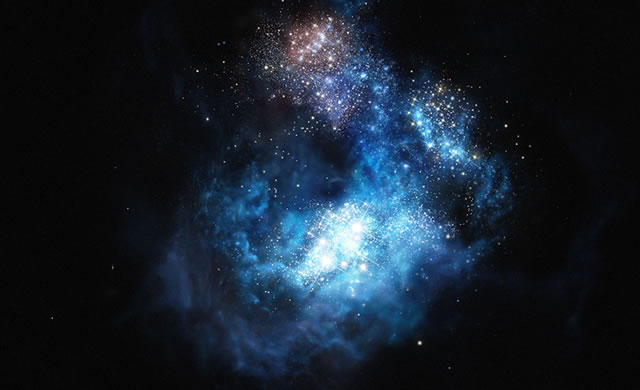
Credit: ESO/M. Kornmesser
Alcuni astronomi, usando il VLT dell’ESO, hanno scoperto la galassia più brillante mai trovata nell’Universo primevo e hanno trovato evidenza che essa contenga esempi di stelle di prima generazione. Questi oggetti massicci e brillanti, finora solo previsti delle teorie, hanno prodotto i primi elementi pesanti della storia – gli elementi necessari per forgiare le stelle oggi intorno a noi, i pianeti che le orbitano e la vita come la conosciamo. La nuova galassia, chiamata CR7, è tre volte più brillante della più brillante galassia distante nota finora.
Gli astronomi hannno teorizzato a lungo l’esistenza di una prima generazione di stelle – note come stelle di Popolazione III – nate dalla materia primordiale del Big Bang. Tutti gli elementi chimici più pesanti – ossigeno, azoto, carbonio e ferro, essenziali per la vita – sono stati prodotti all’interno delle stelle. Ciò significa che le prime stelle devono essersi formate dagli unici elementi che già esistevano: idrogeno, elio e tracce di litio. Queste stelle di Popolazione III sarebbero state enormi – parecchie centinaia o migliaia di volte più massicce del Sole – ardenti e transitorie – dovendo esplodere come supernove dopo solo due milioni di anni. Ma finora la ricerca di una prova fisica della loro esistenza è stata inconcludente.
Fonte/Leggi tutto → ESO.org
Astronomers using ESO’s Very Large Telescope have discovered by far the brightest galaxy yet found in the early Universe and found strong evidence that examples of the first generation of stars lurk within it. These massive, brilliant, and previously purely theoretical objects were the creators of the first heavy elements in history — the elements necessary to forge the stars around us today, the planets that orbit them, and life as we know it. The newly found galaxy, labelled CR7, is three times brighter than the brightest distant galaxy known up to now.
Astronomers have long theorised the existence of a first generation of stars — known as Population III stars — that were born out of the primordial material from the Big Bang. All the heavier chemical elements — such as oxygen, nitrogen, carbon and iron, which are essential to life — were forged in the bellies of stars. This means that the first stars must have formed out of the only elements to exist prior to stars: hydrogen, helium and trace amounts of lithium. These Population III stars would have been enormous — several hundred or even a thousand times more massive than the Sun — blazing hot, and transient — exploding as supernovae after only about two million years. But until now the search for physical proof of their existence had been inconclusive.
Source/Continue reading → ESO.org





















